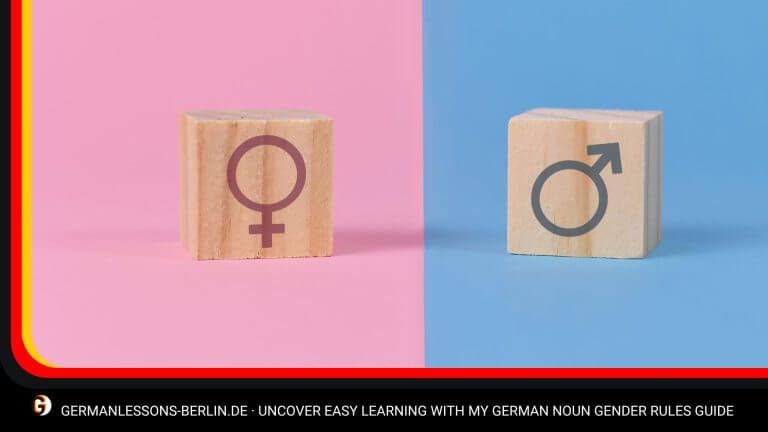Table of Contents
When I embarked on my journey of German language learning, I quickly realized that embracing the nuances of German sentence structure was key to sounding like a true enthusiast, not just a learner. It’s a mix of familiar concepts wrapped in a unique German grammar twist! While German sentence structure for learners may present a formidable challenge at first glance, the rewards of perseverance are clear, eloquent expression and deeper understanding. Whether I’m engaging in everyday conversation or dissecting complex literary texts, the patterns of the German language hold the secret to fluency. So, let’s break down these patterns together!
Key Takeaways
- German and English share a basic SVO sentence structure, providing a comfortable starting point for English speakers learning German.
- The German case system includes nominative, accusative, dative, and genitive cases, each playing a specific role in sentence construction.
- Understanding the role of subjects, verbs, and objects in sentence construction is integral to mastering German grammar.
- Knowing where to position flat adverbs and separable prefixes can elevate your German language skills.
- A solid grasp of constructing negative sentences and questions is crucial for natural and effective communication in German.
- With practice, the principles governing German sentence structure can become intuitive, even for beginners.
Demystifying German Sentence Patterns for Effective Communication
When I set out to learn the German language, I found that the key to effective communication lay in grasping the complexities of German sentence patterns and German sentence construction. As I explored deeper, I discovered that the essence truly rested on three main building blocks: the subject, verb, and object. Despite initial trepidation, it became evident that the fundamentals of German are built upon a structure that mirrors English in many ways, offering comfort in the form of familiar SVO patterns.
The Key Elements of German Sentence Construction
Imagine constructing a building from the ground up. The sturdy foundation of German sentence construction acts similarly, where subjects, verbs, and objects are the cornerstone materials. Within the realms of the German language, subjects take on the action, originating from the nominative case, while the verbs, poised as action symbols, breathe life into the sentence. Direct objects, cradled in the accusative case, are on the receiving end of these actions and indirect objects, draped in the dative case, revel as the beneficiaries. These components are ever-present companions, guiding the way towards coherent and clear dialogue.
Building Blocks: Understanding Subject, Verbs, and Objects
Embarking on a journey to learn German language intricacies led me to a profound appreciation for the structure of the common German sentence. At its heart lies an intimate relationship between the subject, the verbs, and the objects – each holding a pivotal role in how ideas are formed and communicated. I relished discovering the ingenious way direct and indirect objects can dance around the verb, aligning themselves to express an array of nuances without faltering in delivering a clear message.
Here’s an illustrative table showcasing fundamental German sentence patterns that helped me visualize the standard SVO structure:
| Subject (Nominative) | Verb (Second Position) | Direct/Indirect Object (Accusative/Dative) |
|---|---|---|
| Ich (I) | sehe (see) | den Hund (the dog) / dem Mann (to the man) |
| Du (You) | gibst (give) | das Buch (the book) / der Frau (to the woman) |
| Er (He) | schreibt (writes) | einen Brief (a letter) / seiner Schwester (to his sister) |
As illustrated above, the core German sentence structure building blocks function together in a delicate balance, creating sentences that resonate with clear intent. Through dedicated practice and exploration, 3 becomes not just a number, but a symbol of German language structure mastery – a trifecta of elements breathing life into conversation and the written word.
Whether it’s decoding the rhythmic flow of a novel or piecing together my thoughts to share with a friend, the role of verbs tucked comfortably in the second position, or the seamless positioning of objects, has become a source of not only understanding but also creativity. As I continue to learn the German language, I am constantly reminded of the power held within the simplicity of these structural elements.
The Role of Cases in Shaping German Syntax
As I delved deeper into the realm of the German language, I became intimately familiar with the critical function that German Prepositions and Cases Overview play in the fabric of German sentence construction. The nominative, accusative, dative, and genitive cases are not just mere formalities but the backbone of meaningful communication. My journey into understanding these cases was transformative, transitioning from a stage of puzzlement to one of profound clarity and appreciation for the language’s structure.
How Nominative, Accusative, Dative, and Genitive Define Sentence Roles
The nominative case, a frontrunner in the sentence, is the subject, the doer of the action—it’s the marching band leader, setting the pace and direction. Accusative case nouns follow closely behind, directly receiving the action. Interactions of the verb with the accusative case are akin to the baton pass in a relay race—swift, direct, and crucial for sentence progression.
The dative case enters the equation when indirect objects are highlighted, playing the role of the beneficiary. One could compare its role to a supportive audience member who cheers on the performers. Lastly, the genitive case wraps possessive relationships in a sentence with elegance, much like a conductor’s baton which guides the beautiful symphony of words and phrases.
Grasping these roles underpins my newfound flexibility in sentence construction, a twist to word orders that English strictly doesn’t allow. The tableau below paints a vivid picture of how these cases interact and intersect to infuse meaning into each component of a sentence, allowing multiple structurally different nominations that resonate with the same intent.
| Case | Function in the Sentence | Example |
|---|---|---|
| Nominative | Subjects | Der Hund (The dog) – Der Hund spielt (The dog plays) |
| Accusative | Direct Objects | Den Ball (The ball) – Ich werfe den Ball (I throw the ball) |
| Dative | Indirect Objects | Dem Mann (To the man) – Ich gebe dem Mann den Ball (I give the man the ball) |
| Genitive | Possession / Associations | Des Hundes Ball (The dog’s ball) – Die Farbe des Hundes (The color of the dog) |
The flexibility these cases bestow upon the German language is a dance of grammar and meaning, one that I cherish as I string words into sentences. As I continue to immerse myself in the language, these cases become close companions, reminding me that language is more than just rules—it’s an art form expressively painted with words.
How to Arrange Words for Standard German Statements
My journey in german language comprehension has revealed that German statements word order holds an instrumental role in crafting clear expressions. As I advance in constructing German sentences, I find myself aligning with the quintessential order of subject, verb, followed by other elements such as objects or adverbs—similar to the foundations of my English-speaking background.
When multiple objects enter the scene, I observe a grammatical hierarchy. Direct objects naturally take precedence over indirect objects within sentences. The placement of verbs adapts to this structure, particularly when working with separable prefixes or when the course of a sentence leads into negation. It’s a unique challenge that morphs into a delightful puzzle, fitting each word meticulously to unveil a coherent statement.
In the table below, I exemplify the fundamental order of a German sentence, highlighting the placement of subjects, verbs, and the supporting cast of objects:
| Sentence Component | Example in German | English Translation |
|---|---|---|
| Subject | Der Junge | The boy |
| Verb | gibt | gives |
| Direct Object | der Frau | the woman |
| Indirect Object | das Buch | the book |
Context often dictates whether the direct or indirect object will step into the spotlight, adjusting the verb’s placement to enhance clarity. This dynamic becomes even more intriguing when German leans on its malleable rules, allowing a free dance of word order that English would see as a misstep. What fascinates me is this linguistic flexibility, coupled with firm guidelines—an interplay that allows each sentence to flourish with precisely etched intent.
Stepping into the intricacies of German sentence construction, I increasingly respect the depth and fluidity of the language. While I revel in the opportunity to structure sentences with the freedom German grants, I also recognize the responsibility to maintain the essence and accuracy of every statement.
Formulating Questions in German: Word Order Demystified
Mastering the art of asking questions in German requires understanding the dance of sentence structure, specifically German word order questions. Let me take you on a linguistic adventure where I discovered how questions in the German language follow a logical sequence—often mirroring the familiar structure used in English.
My experience has shown that for yes-or-no questions, German pivots the sentence by placing the verb at the forefront, setting the stage for either affirmation or denial. For instance, the simple question, “Spielen Sie Schach?” (Do you play chess?) follows the direct verb-subject-object pattern, aligning with the English “Do you play chess?” This rule acts as a delightful constant in the sea of German syntax complexities.
Delving deeper, interrogative phrases commence with the probing question words such as “warum” (why) or “wo” (where), immediately captivating the listener’s curiosity. These question words, known as W-Wörter in German, anchor the sentence, followed by the verb and subject, a construct that matches the English equivalent and eases the learning curve for English speakers venturing into German.
Wie lange werden Sie bleiben? – How long will you stay?
But what truly fascinated me is the strategic maneuver required when integrating two verbs within a question. Here, the primary verb, conjugated to match the subject, claims its rightful place in the second position. Meanwhile, the secondary verb, often an infinitive or participle, patiently waits at the end of the sentence. The duality of verbs, one conjugated and one uninfluenced, provides a rich layer to the texture of German discourse.
| Question Type | Example in German | English Translation |
|---|---|---|
| Yes-or-No Question | Haben Sie Zeit? | Do you have time? |
| Interrogative Question | Warum lernen Sie Deutsch? | Why are you learning German? |
| Question with Two Verbs | Können Sie mir helfen, Deutsch zu lernen? | Can you help me learn German? |
As I tread along my German learning path, I’ve come to appreciate how these guidelines provide a launching pad for constructing questions with precision. Combining the verb’s commanding presence with the flexibility of question words, asking questions in German evolves from a mere language task to an expressive journey through the mindscape of human inquiry. Let’s continue to unravel the charm of German word order, one question at a time.
Navigating Verbs in German: The Power of Proper Placement
As I’ve progressed in my German studies, I’ve encountered different types of verbs that have challenged my understanding of syntax. An integral part of language mastery involves differentiating between German separable verbs and German inseparable verbs and recognizing their correct placement in sentences.
Separable and Inseparable Verbs: Knowing the Difference
What caught my attention early on were the German separable verbs. These verbs carry affixed elements that detach and reattach elsewhere within a sentence, impacting the flow and meaning. The verb’s conjugated stem stands proudly next to the subject, but its prefix ventures to the end, like a final flourish in a musical piece.
In contrast, German inseparable verbs do not permit such division. The prefix steadfastly clings to the verb, maintaining their unity throughout the conjugation process. These verbs feel more familiar to me, as they respect a consistent order which doesn’t require reassembly of parts.
Here’s a table that gives me clarity on how these verbs transform within a sentence:
| Verb Type | German Example | Translation |
|---|---|---|
| Sepable Verb | Ich fange den Tag mit Kaffee an. | I start the day with coffee. |
| Inseparable Verb | Ich verstehe die deutsche Grammatik. | I understand German grammar. |
Tackling the Verb-Complement Structure in German
Another aspect of German that intrigues me is the German verb-complement structure, which introduces the dance between an auxiliary verb and a primary verb. The auxiliary verb, being the supportive partner, gets conjugated and takes the second place in the sentence’s order, leading the way.
The main verb, which carries the essence of the action or state, is typically at rest in its infinitive or past participle form at the sentence’s end. It’s like the last note in a song, leaving a lingering impression, as in the familiar past tense construction when recounting stories or events.
Ich habe gestern Abend einen Film gesehen.
This means, “I watched a movie last night.” The conjugated auxiliary verb “habe” (have) is followed by the participle “gesehen” (watched) to complete the past tense narrative.
Understanding the interplay of these structures—where to place the movable pieces of separable verbs and the spine of the verb-complement structure—has enriched my ability to construct meaningful and varied sentences in German.
In conclusion, number 7 seems to be my lucky number when grappling with German verbs. There’s a certain magic to unlocking the sequence of components that allows the language to flow naturally, precisely as a native speaker would orchestrate it. Whether dealing with separable or inseparable verbs, their placement influences the harmony of communication and, therefore, grasp of this elegant language.
Switching It Up: The Inverted Sentence Structure in German
Have you ever noticed how altering the sentence structure can add a surprising twist to your expression? With the inverted sentence structure in German, I found a fascinating way to shift the standard German word order and emphasize different parts of my speech. This practice, while maintaining the sentence’s core message, invites a fresh angle into the dialogue—one that captures attention and holds it with a finespun blend of anticipation and clarity.
The core trick lies in positioning elements—who would usually rest comfortably behind the subject—at the sentence’s forefront. These elements could be adverbials or objects, but what follows is an essential cookie-cutter rule: the verb precedes the subject. This reordering is not something English allows us to toy with, hence why it feels particularly delightful in German!
Normalerweise beginne ich meinen Tag mit Kaffee. – Typically, I start my day with coffee.
But watch what happens when I flip the script with an inverted sentence structure:
Mit Kaffee beginne ich normalerweise meinen Tag. – With coffee, I typically start my day.
The intent remains intact, but the inverted sentence structure in German has placed a gleaming spotlight on that morning cup of joe, emphasizing its importance in my daily ritual. It’s as if the coffee itself receives a moment of special recognition before the sentence carries on in its conventional manner.
Let’s explore a table that outlines a few examples of how the inverted sentence structure in German can transform an ordinary statement:
| Standard Word Order | Inverted Sentence Structure |
|---|---|
| Ich kaufe oft im Supermarkt ein. | Im Supermarkt kaufe ich oft ein. |
| Er besucht uns am Wochenende. | Am Wochenende besucht er uns. |
| Sie macht jeden Tag Yoga. | Jeden Tag macht sie Yoga. |
As I’ve honed my German language skills, I’ve learned that utilizing the inverted sentence structure can create sentences that resonate with a unique rhythm and emphasis. It’s an artful dance, one that weaves familiar words into an intricate tapestry, revealing new shades of meaning that may have otherwise stayed hidden within the confines of the common German word order.
While toying with the German word order may initially seem daunting, its mastery has proven to be an enriching addition to my linguistic repertoire. It’s like discovering a secret passage that leads to a hidden garden of expressiveness—one that I’m now eager to explore further in my German conversations.
Adding Negation to Your German Sentences Correctly
As I’ve ventured further into the intricacies of the German language, I’ve come to understand the power that just one word can have in changing the sentiment of a sentence. In English, we’re familiar with using “not” and “no” to negate a statement. Similarly, in German, negation is an equally essential component of the language, and mastering the use of ‘nicht’ and ‘kein’ has been crucial in crafting accurate German negative sentences.
Placing ‘Nicht’ and ‘Kein’ in German Statements
Initially, I found it a bit daunting to figure out the correct placement of ‘nicht’ and ‘kein’. I’ve learned that these words modify the action of the verb, so they typically come after the verb and before the adverbs or adjectives. The subtle difference between these two types of German negation hinges on whether you’re negating the existence of something (using ‘kein’) or negating an action or a state (using ‘nicht’).
Ich habe einen Hund. – I have a dog.
Ich habe keinen Hund. – I do not have a dog.
The sentence showcases the use of ‘kein’, indicating the absence of something—here, a pet dog.
Ich spiele oft Tennis. – I often play tennis.
Ich spiele nicht oft Tennis. – I don’t often play tennis.
The example above uses ‘nicht’ to negate the act of frequently playing tennis, rather than the existence of any tennis playing ability at all.
To give a structured breakdown, let’s look at how ‘nicht’ and ‘kein’ fit into the German sentence structure:
| German Sentence | Negation Type | Negated Sentence | Translation |
|---|---|---|---|
| Er trinkt den Kaffee. | Nicht (Action) | Er trinkt den Kaffee nicht. | He does not drink the coffee. |
| Er hat Kaffee. | Kein (Existence) | Er hat keinen Kaffee. | He has no coffee. |
| Sie lernt schnell. | Nicht (Manner) | Sie lernt nicht schnell. | She does not learn quickly. |
| Sie hat Geld. | Kein (Existence) | Sie hat kein Geld. | She has no money. |
Through plenty of practice, I’ve found that determining when to use ‘nicht’ or ‘kein’ depends crucially on the focus of the negation within my German negative sentences. Once I grasped this concept, adding a splash of negation here and there in my conversations and writings no longer seemed like an unsurmountable challenge. It’s a matter of attention to detail—recognizing whether I’m negating the existence of a noun or the verb’s action. From there, it becomes another delightful dimension of expression in my growing German language toolkit.
Conjunction Junction: Navigating Sentence Connections
On my path to deciphering the ins and outs of the German language, I’ve grown to appreciate the power of German conjunctions in enriching conversations and text. Understanding how to correctly use these small but mighty links known as German sentence connections plays a significant role in my ability to create cohesive and comprehensible sentences.
When I first considered coordinating conjunctions, like ‘und’ (and) or ‘dass’ (that), I was comforted by their similarity to English, as they don’t change the original word order of a sentence. However, it was the subordinating conjunctions, such as ‘weil’ (because), where the real adventure began. They introduced a shift in sentence structure I had not previously encountered, adding an intriguing twist to my linguistic toolkit.
Ich spiele Tennis, und ich schwimme auch gern.
I play tennis, and I also like to swim.
This example with ‘und’ maintains the familiar word order, which makes for an easier transition for English speakers like myself. Moving along to the more complex subordinating conjunctions, I learned that these actually change the position of the verb to the end of the clause, a concept that initially seemed foreign to me:
Ich mache Hausaufgaben, weil ich gute Noten bekommen möchte.
I do homework, because I want to get good grades.
The role of these conjunctions goes beyond simple linking: they specify the nature of the relationship between clauses thus providing clarity about the interrelation of sentence parts and their communicative goal.
Being cognizant of this subtle yet impactful distinction has not only sharpened my grammatical precision but has also deepened my understanding of the German language’s flexibility and nuance. Let’s look at a table I constructed to illustrate the contrast between coordinating and subordinating conjunctions:
| Conjunction Type | German Example | Translation | Effect on Word Order |
|---|---|---|---|
| Coordinating | Er liest und schreibt. | He reads and writes. | No change |
| Subordinating | Ich lerne Deutsch, weil es nützlich ist. | I’m learning German because it’s useful. | Verb to the end |
This comparison clarified how each type of conjunction influences my sentences. Armed with this knowledge, I feel more equipped to navigate the intricacies of German sentence connections and enhance my fluency.
As I continue on my journey, diving deeper into the realm of German language mastery, every encounter with these connective elements strengthens my ability to express complex thoughts with greater clarity—an essential step in sounding less like a learner and more like a native speaker.
Conclusion: Transforming Challenges into Achievements in German Language Mastery
Embarking on the path to German language mastery has been a journey studded with enlightening challenges and rewarding discoveries. Grappling with the intricacies of sentence structure has unveiled a landscape of language far more manageable than I initially imagined. My understanding of German syntax has deepened, thanks to a keen grasp on the dynamics of word order, the significance of grammatical cases, and the strategic use of negation and conjunctions. With each sentence I construct, the alignment of subjects, verbs, and objects in the context of cases like nominative and accusative becomes more than just grammatical compliance; it transforms into an expression of clarity and intent.
As with any language endeavor, practice is the cornerstone upon which fluency is built. Each exercise in verb placement or each flirtation with an inverted sentence reinforces my linguistic intuition, turning once-daunting German syntactic puzzles into patterns that feel increasingly natural. The once perplexing aspects of German syntax that had the potential to bemuse and bewilder now segue into second nature as I continue to immerse myself in the ebb and flow of the German tongue.
In retrospect, each step taken toward mastering the German language is a testament to the achievable nature of this linguistic goal. Through consistency, keen observation, and an embrace of both the similarities to and differences from my native English, German grammar and sentence construction now offer a satisfying sense of accomplishment. Navigating the nuances of German language mastery has proven to be not only educational but also distinctly gratifying, fortifying my desire to continue exploring the depths of this rich language.
FAQ
What are the essential components of German sentence structure?
The essential components of a German sentence structure are subjects, verbs, and objects. The subject typically is in the nominative case and performs the action. The verb indicates the action or state of being, and objects can be direct (accusative case) or indirect (dative case), depending on their role in the sentence.
How do German grammatical cases impact sentence construction?
German grammatical cases – nominative, accusative, dative, and genitive – determine the function of nouns and pronouns in a sentence and influence word order. They dictate who is doing an action, who is affected by it, and who benefits from it, providing flexibility in how sentences can be constructed.
What is the typical word order for standard German statements?
Standard German statements usually follow a Subject-Verb-Object order, similar to the English structure. However, other elements like indirect objects, time expressions, and adverbs have their own hierarchical order that typically comes after the direct object.
How is the word order structured when asking questions in German?
In German yes-or-no questions, the verb typically precedes the subject. When a question word like “warum” or “wo” is used, it starts the question, followed by the verb and then the subject. If there are two verbs, the conjugated verb is positioned second within the question, and the other verb goes to the end.
What are separable and inseparable verbs in German?
Separable verbs in German have a prefix that can detach from the main verb and move to the end of the sentence, while the core verb stays next to the subject. Inseparable verbs, on the other hand, maintain their prefixes attached in all tenses and do not affect the sentence structure.
How does the verb-complement structure work in German?
The verb-complement structure in German sentences often involves an auxiliary verb and a main verb. The auxiliary verb is conjugated and placed in the second position, while the main verb in its infinitive or participle form goes to the end of the sentence. This structure is particularly important for forming past tense sentences.
What is the inverted sentence structure in the German language?
The inverted sentence structure occurs when a sentence begins with an element other than the subject, such as an adverbial phrase or object. The verb is then positioned after this initial element with the subject coming later, which allows for emphasis on different parts of the sentence without changing its basic meaning.
How and where do you use ‘nicht’ and ‘kein’ for negation in German sentences?
‘Nicht’ and ‘kein’ are used to negate sentences in German. ‘Nicht’ usually follows the verb and comes before adverbs or adjectives, while ‘kein’ replaces ‘ein’ before a noun to indicate the negation of ‘a’ or ‘an’. Their placement will vary depending on what part of the sentence is being negated.
How do conjunctions affect the word order in German sentences?
Coordinating conjunctions, like ‘und’ (and), do not change the word order in German. However, subordinating conjunctions, such as ‘weil’ (because), push the conjugated verb to the end of the clause, altering the word order to clearly show the relationship between the main and subordinate clauses.




